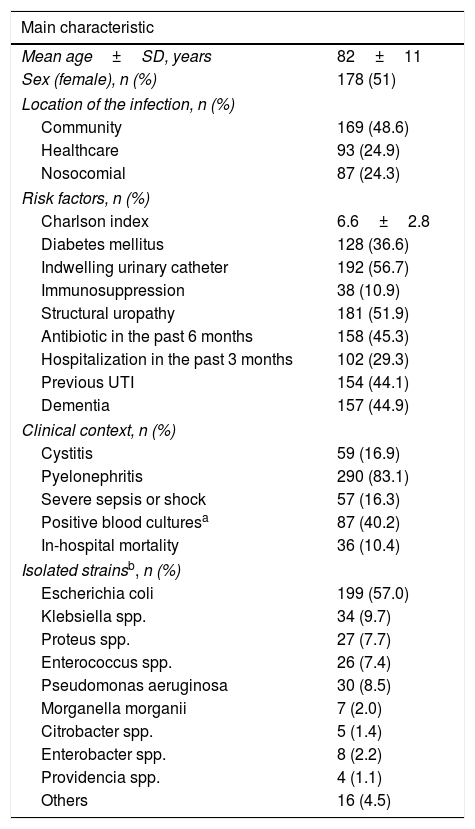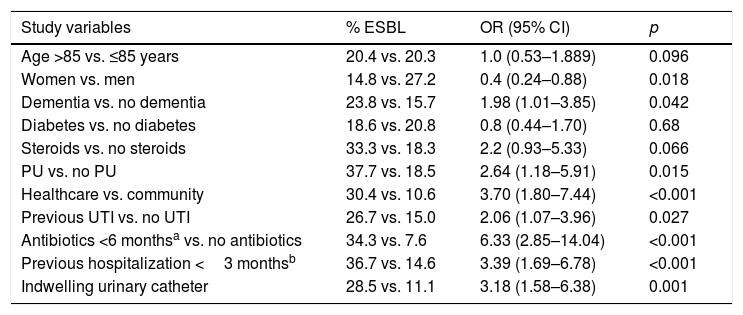Urinary tract infections (UTIs) are one of the most frequent infections. In the elderly, they have multiple comorbidities. The objective of this work is to describe the clinical and microbiological epidemiology of elderly persons admitted for UTIs and to evaluate the suitability of empirical treatments and their implications regarding mortality.
Material and methodsAn observational study was conducted during 2013–2015 in 4 public hospitals, with patients older than 65 years who were admitted to the Internal Medicine service with a microbiological diagnosis of UTI. Cases of asymptomatic bacteriuria were excluded. In-hospital mortality was analyzed. Univariate analysis and multivariate analysis was carried out.
ResultsA total of 349 episodes were selected, with a mean age of 82±11 years, 51% female. Mortality was 10.3% and was associated with age, dementia and sepsis and septic shock (p<0.05). The most frequent organisms were Escherichia coli (E. coli) (53.6%), Klebsiella spp. (8.7%) and Enterococcus spp. (6.6%). E. coli and Klebsiella spp. with extended-spectrum beta-lactamases (13% of the total isolated) were associated with the previous use of antibiotics, community care treatment and a permanent urinary catheter (p<0.05). The empirical treatment was adequate only in 73.6% of cases. As these treatments were associated with higher mortality, they were not considered adequate.
ConclusionsIn the elderly, UTIs show a high mortality. Empirical treatment is often inadequate and may be associated with increased mortality.
Las infecciones del tracto urinario (ITU) constituyen una de las infecciones más frecuentes. En el anciano presentan diversas comorbilidades. El objetivo de este trabajo es conocer la epidemiologia clínica y microbiológica en el anciano ingresado por ITU y evaluar la idoneidad de los tratamientos empíricos y su implicación con la mortalidad.
Material y métodosEstudio observacional del 2013 al 2015 en 4hospitales en pacientes mayores de 65 años ingresados en Medicina Interna con diagnóstico clínico y confirmación microbiológica. Se excluyeron los casos de bacteriuria asintomática. Se evaluó la mortalidad intrahospitalaria. Se realizó un análisis univariante y multivariante.
ResultadosSe seleccionaron 349 episodios de pacientes con edad media 82 ±11 años, 51% mujeres. La mortalidad fue del 10,3%, asociada a la edad, demencia y presentación como sepsis grave/shock séptico (p < 0,05). Los aislamientos más frecuentes fueron Escherichia coli (E. coli) (53,6%), Klebsiella spp. (8,7%) y Enterococcus spp. (6,6%). Un 13% del total de los aislamientos correspondían a E. coli y Klebsiella spp. con betalactamasas de espectro extendido; el uso previo de antibióticos, cuidados socio-sanitarios y catéter urinario permanente fueron predictores independientes (p < 0,05). El tratamiento empírico resultó adecuado solo en el 73,6% de los casos. La falta de adecuación se asoció a una mayor mortalidad (p < 0,05).
ConclusionesLa ITU del anciano que ingresa presenta una alta mortalidad. El tratamiento empírico es frecuentemente inadecuado y puede asociarse a una mayor mortalidad.
Article
Diríjase desde aquí a la web de la >>>FESEMI<<< e inicie sesión mediante el formulario que se encuentra en la barra superior, pulsando sobre el candado.

Una vez autentificado, en la misma web de FESEMI, en el menú superior, elija la opción deseada.

>>>FESEMI<<<







